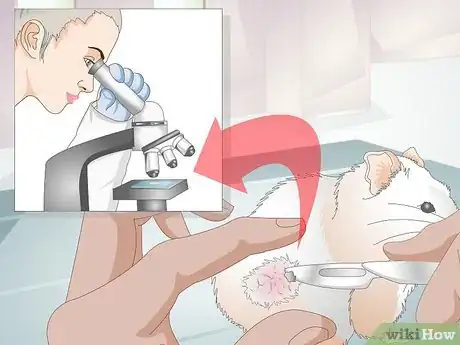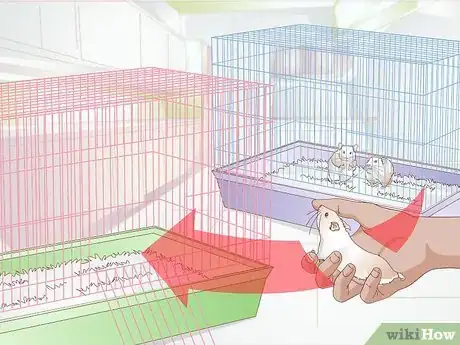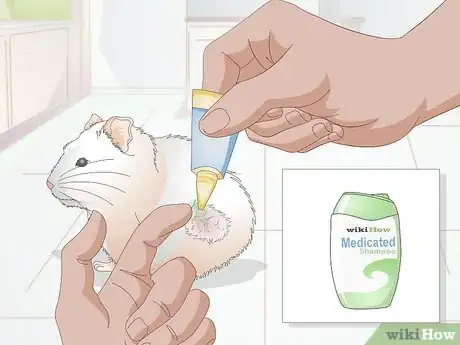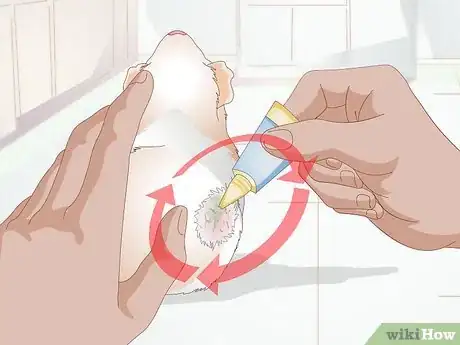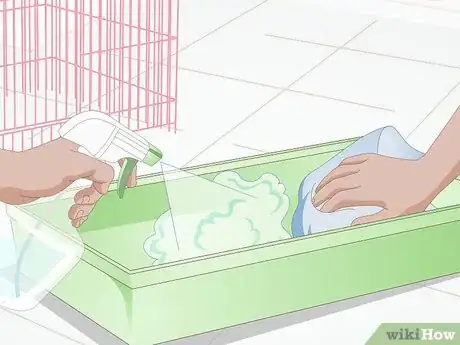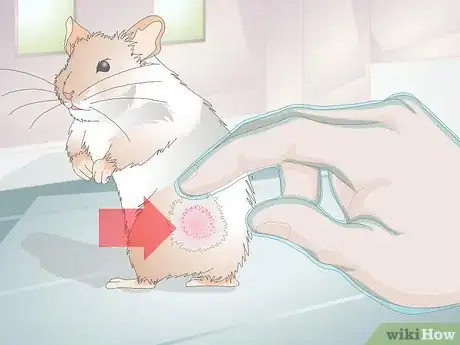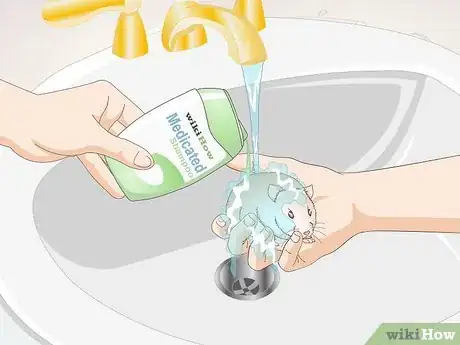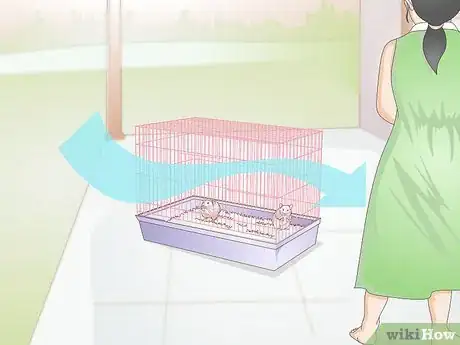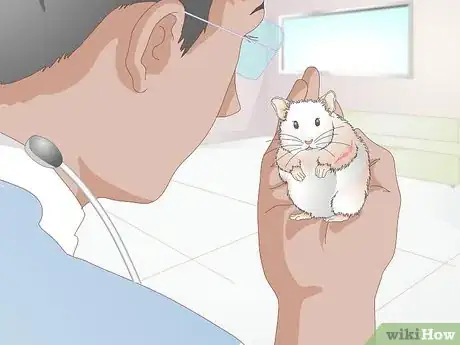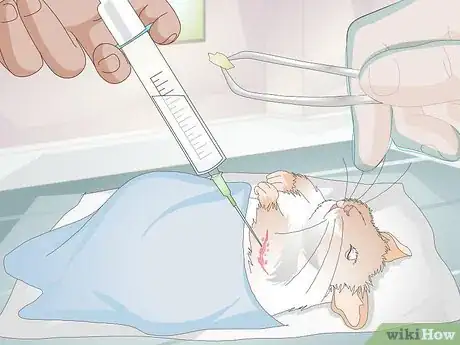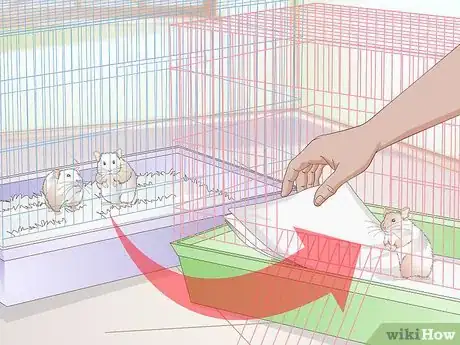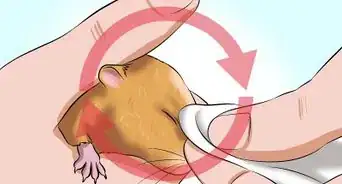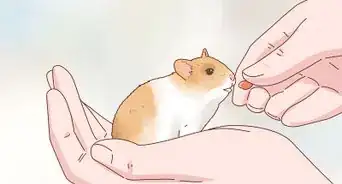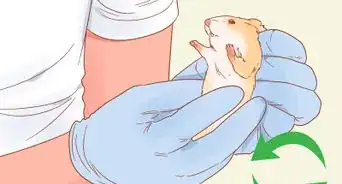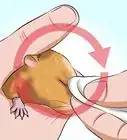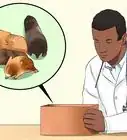This article was co-authored by Pippa Elliott, MRCVS. Dr. Elliott, BVMS, MRCVS is a veterinarian with over 30 years of experience in veterinary surgery and companion animal practice. She graduated from the University of Glasgow in 1987 with a degree in veterinary medicine and surgery. She has worked at the same animal clinic in her hometown for over 20 years.
There are 13 references cited in this article, which can be found at the bottom of the page.
This article has been viewed 47,156 times.
Several types of skin diseases, such as mites and ringworm, can affect pet hamsters. Most of these skin diseases are caused by parasites or an infection.[1] Skin disease can make a hamster feel very uncomfortable. Once you recognize a skin problem on your hamster, take your hamster to your vet and carefully follow all treatment instructions.
Steps
Treating Skin Mites in Hamsters
-
1Take your hamster to your vet. Mites are one of the most common skin diseases in hamsters. Your vet will diagnose mites by taking a skin scrape (thin scrape of skin using a scalpel blade) and analyzing it with a microscope.[2] Your vet may also brush your hamster while holding a white piece of paper to catch the mites. Your vet would then look at the mites with a magnifying glass.[3]
- Two species of mites can affect hamsters. One of the species, Demodex criceti, is fairly easy to see and will look short and squat when viewed with a microscope.[4]
-
2Isolate your hamster. If you have multiple hamsters, isolate the one with mites until after treatment is complete.[5] Mites are contagious, so you would not want your healthy hamsters developing a mite problem. If multiple hamsters are affected, treat them all at the same time.Advertisement
-
3Treat your hamster as prescribed. Several treatments are available for treating mites. One treatment is medicated shampoo. However, hamsters don’t like baths very much, so your hamster may resist getting bathed with the medicated shampoo.[6] Another treatment is a medicated ointment that you would apply to the affected skin areas.[7]
- Oral ivermectin, which kills parasites, is a treatment option.[8] You would place the prescribed number of ivermectin drops into your hamster’s mouth.
- Anti-mite sprays are available as an over-the-counter treatment.[9] Talk with your vet before using an over-the-counter medication on your hamster.
- A whole body dip is recommended for severe mite infestations. This dip would be with a medicated bath product containing ivermectin.[10] Your vet would explain how to perform this dip at home.
-
4Repeat treatment, if necessary. Old hamsters and those with a weak immune system may need to be treated for mites more than once.[11] Talk with your vet before repeating treatment.
-
5Clean your hamster’s cage. Hamsters can get mites from their cage bedding. Therefore, cleaning and disinfecting your hamster’s cage is essential to treating mites. First, remove everything from the cage and throw away all of the bedding. Wash the entire inside of the cage with hot, soapy water and a sponge or scrub brush.
- Wash all of cage accessories (food bowl, water bottle, plastic toys) with hot, soapy water as well.[12]
- Use a hamster-safe cage disinfectant, which is available at your local pet store. Disinfect the cage and the cage accessories according to product label instructions.
- Allow everything to dry before placing the items back in the cage. Use clean, fresh bedding.
Treating Ringworm in Hamsters
-
1Have your vet diagnose ringworm. The term ‘ringworm’ is misleading because ringworm is actually caused by a fungus (Trichophyton mentagrophytes, Microsporum). If your hamster has ringworm, you will see patches of hair loss where the skin looks crusty, flaky, and red. Your vet will diagnose ringworm by looking at the affected skin with a special lamp and examining some of your hamster’s fur with a microscope.[13]
- The affected areas of skin look like rings.
- Ringworm is common in older hamsters.[14]
-
2Follow treatment instructions. Several treatment options are available for ringworm. One option is medicated shampoo, containing either povidone iodine (antibacterial) or an antifungal medication. Consider trimming your hamster’s fur before the bath so the shampoo is most effective.[15] Be mindful that your hamster may resist getting bathed.
- Topical treatment with griseofulvin, an antifungal medication, is another treatment option. Your vet would shave the affected skin areas first, then you would apply the ointment at home as prescribed.[16]
- Isolate the affected hamster during treatment.[17]
- Treatment for ringworm usually lasts 18‒21 days.[18]
- Hamster ringworm is contagious to humans, so you should wear gloves when handling your hamster and wash your hands after handling.[19]
-
3Clean your hamster’s cage. A hamster can get infected with ringworm from its cage bedding. Clean the cage and its contents with hot, soapy water. Throw away all the bedding and put in clean bedding when the cage is completely dry. As with handling your hamster, wear gloves when cleaning its cage.[20]
-
4Keep the cage well ventilated. If your hamster’s cage doesn’t get much fresh air, it could become damp inside, which would promote fungal growth and increase the risk of a ringworm infection.[21] If you do not have a wire cage, consider purchasing one. A wire cage would have great ventilation.
- If buying a new cage is not practical, purchase a wire cage top to improve the cage's ventilation.
Treating Skin Wounds in Hamsters
-
1Take your hamster to your vet. A hamster can get a skin wound by fighting with its cage mate or getting scratched by sharp bedding. This wound can become infected, causing an abscess (pocket of infection) to form. When you take your hamster to your vet, they will take a sample from the wound to identify the type of bacteria in the wound.[22] The type of bacteria will determine which antibiotic will work the best.
- Territorial female hamsters can bite each other.[23]
-
2Allow your vet to treat the wound. If an abscess has formed, your vet will surgically remove it and inject an antibiotic in the affected area. If the abscess ruptures on its own before surgical treatment, your vet will drain the abscess and flush the area with an antiseptic until it’s clean. For at-home care, your vet will prescribe an antibiotic ointment that you would apply to the affected area.[24]
-
3Remove the cause of the wound. If your hamster has a bite wound from its cage mate, put the hamsters in separate cages. If the wound was caused by sharp bedding, replace the bedding with something soft, like shredded toilet paper or paper towel.[25] [26] By removing the cause the wound, you can help prevent future skin wounds.
Warnings
- Griseofulvin can cause serious side effects in hamsters, such as diarrhea. It can also birth defects, so it should not be used in pregnant animals.[31] [32]⧼thumbs_response⧽
- A bacterial infection can develop in severe cases of ringworm.[33]⧼thumbs_response⧽
- Hair loss in hamsters may be due to diseases that cause hormonal imbalances (e.g., adrenal tumor, kidney failure, thyroid problems). The underlying disease may not be treatable.[34]⧼thumbs_response⧽
References
- ↑ http://www.merckvetmanual.com/pethealth/exotic_pets/hamsters/disorders_and_diseases_of_hamsters.html#v3227942
- ↑ http://www.vetbase.co.uk/information/skin-diseases-hamsters.php
- ↑ https://www.caringpets.org/how-to-take-care-of-a-hamster/illnesses/mites-demodex-sarcoptic-acariasis/
- ↑ http://www.britishhamsterassociation.org.uk/get_article.php?fname=journal/dermatitis.htm
- ↑ https://www.caringpets.org/how-to-take-care-of-a-hamster/illnesses/mites-demodex-sarcoptic-acariasis/
- ↑ https://www.caringpets.org/how-to-take-care-of-a-hamster/illnesses/mites-demodex-sarcoptic-acariasis/
- ↑ http://www.merckvetmanual.com/pethealth/exotic_pets/hamsters/disorders_and_diseases_of_hamsters.html#v3227942
- ↑ http://netvet.co.uk/hamsters/skin-diseases.htm
- ↑ http://hamstersaspets.co.uk/hamster-mites/
- ↑ http://www.britishhamsterassociation.org.uk/get_article.php?fname=journal/dermatitis.htm
- ↑ http://www.britishhamsterassociation.org.uk/get_article.php?fname=journal/dermatitis.htm
- ↑ http://www.pets4homes.co.uk/pet-advice/caring-for-your-pet-hamster.html
- ↑ http://www.merckvetmanual.com/pethealth/exotic_pets/hamsters/disorders_and_diseases_of_hamsters.html#v3227942
- ↑ http://www.britishhamsterassociation.org.uk/get_article.php?fname=journal/dermatitis.htm
- ↑ https://www.caringpets.org/how-to-take-care-of-a-hamster/illnesses/ringworm-fungus/
- ↑ http://www.petmd.com/exotic/conditions/skin/c_ex_hm_ringworm_infection?page=2
- ↑ http://www.vetbase.co.uk/information/skin-diseases-hamsters.php
- ↑ http://www.hammysworld.com/index.php?p=ringworm
- ↑ http://www.merckvetmanual.com/pethealth/exotic_pets/hamsters/disorders_and_diseases_of_hamsters.html#v3227942
- ↑ http://www.merckvetmanual.com/pethealth/exotic_pets/hamsters/disorders_and_diseases_of_hamsters.html#v3227942
- ↑ http://www.britishhamsterassociation.org.uk/get_article.php?fname=journal/dermatitis.htm
- ↑ http://www.merckvetmanual.com/pethealth/exotic_pets/hamsters/disorders_and_diseases_of_hamsters.html#v3227947
- ↑ http://www.britishhamsterassociation.org.uk/get_article.php?fname=journal/dermatitis.htm
- ↑ http://www.merckvetmanual.com/pethealth/exotic_pets/hamsters/disorders_and_diseases_of_hamsters.html#v3227947
- ↑ http://www.merckvetmanual.com/pethealth/exotic_pets/hamsters/disorders_and_diseases_of_hamsters.html#v3227947
- ↑ http://www.petwebsite.com/hamsters/hamster_bedding.asp
- ↑ http://netvet.co.uk/hamsters/skin-diseases.htm
- ↑ http://www.britishhamsterassociation.org.uk/get_article.php?fname=journal/dermatitis.htm
- ↑ http://www.vetbase.co.uk/information/skin-diseases-hamsters.php
- ↑ https://www.caringpets.org/how-to-take-care-of-a-hamster/illnesses/mites-demodex-sarcoptic-acariasis/
- ↑ http://www.hammysworld.com/index.php?p=ringworm
- ↑ http://www.vspn.org/vspnsearch/aow/drugtherapyinpetrodents.htm
- ↑ http://netvet.co.uk/hamsters/skin-diseases.htm
- ↑ http://www.britishhamsterassociation.org.uk/get_article.php?fname=journal/dermatitis.htm
